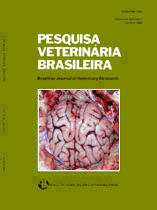 |
|
|
|
Year 2012 - Volume 32, Number 4
|

|
Prevalence and risk factors of bovine leptospirosis in the State of Maranhão, Brazil, 32(4):303-312
|
ABSTRACT.- Silva F.S., Conceição W.L.F., Fagliari J.J., Girio R.J.S., Dias R.A., Borba M.R. & Mathias L.A. 2012. [Prevalence and risk factors of bovine leptospirosis in the State of Maranhão, Brazil.] Prevalência e fatores de risco de leptospirose bovina no Estado do Maranhão. Pesquisa Veterinária Brasileira 32(4):303-312. Departamento de Medicina Veterinária Preventiva e Reprodução Animal, Faculdade de Ciências Agrárias e Veterinárias, Universidade Estadual Paulista, Via de Acesso Professor Paulo Donato Castellane s/n, Zona Rural, Jaboticabal, SP 14884-900, Brazil. E-mail: fjsepi@gmail.com
Prevalence and risk factors of bovine leptospirosis in the State of Maranhão were investigated. Based on production parameters that vary across different production systems, management practices, the purpose of exploitation, the average size of herds and market systems, the state was divided in four sampling circuits. The study aimed to investigate the epidemiological features of bovine leptospirosis in the State of Maranhão, in order to determine the prevalence of the infection in cattle and herds, to determine the occurrence of serovars of Leptospira spp., to identify risk factors associated with leptospirosis in cattle and to differentiate the livestock circuits itself regarding the prevalence of leptospirosis. The survey was conducted in 136 herds in the circuit I, in which 841 ≥ 24 months old females were analyzed; 238 in the circuit II and 2,582 females were analyzed; 122 in the circuit III and 869 females were analyzed; 77 in the circuit IV and 540 females were analyzed; a total of 573 herds and 4,832 females were analyzed. The presence of antibodies against Leptospira spp. was verified by microscopic agglutination test (MAT). Of the 4,832 cows examined, 1,904 (35.94%, CI 95% = 33.01% - 38.98%) were positive. Of the 573 herds, 380 (64.81%, CI 95% = 61.10% - 68.35%) were positive. Serovars Hardjo and Wolffi were the most frequent in the state. The circuit III showed the lowest prevalence of leptospirosis in all comparisons. The variables presence of horses (p = 0.000), presence of capybaras (p = 0.034) and herds with up to 32 adult females (p = 0.002) were identified as risk factors for leptospirosis. |
| |
|
|
| |
|
 |